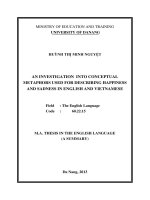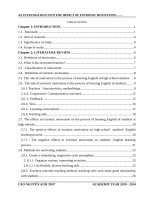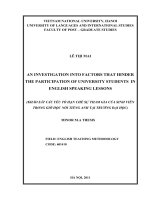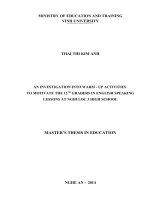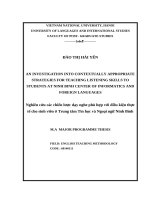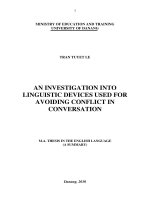an investigation into conceptual metaphors used for describing happiness and sadness in english and vietnamese
Bạn đang xem bản rút gọn của tài liệu. Xem và tải ngay bản đầy đủ của tài liệu tại đây (273.71 KB, 26 trang )
MINISTRY OF EDUCATION AND TRAINING
UNIVERSITY OF DANANG
HUỲNH THỊ MINH NGUYỆT
AN INVESTIGATION INTO CONCEPTUAL
METAPHORS USED FOR DESCRIBING HAPPINESS
AND SADNESS IN ENGLISH AND VIETNAMESE
Field : The English Language
Code : 60.22.15
M.A. THESIS IN THE ENGLISH LANGUAGE
(A SUMMARY)
Da Nang, 2013
This thesis has been completed at College of Foreign Languages,
University of Danang
Supervisor: Assoc. Prof. Dr. PHAN VĂN HÒA
Examiner 1: Assoc. Prof. Dr.TRƯƠNG VIÊN
Examiner 2: Assoc. Prof. Dr. LƯU QUÝ KHƯƠNG
This thesis will be orally defended at the Examination Council at
University of Danang
Time : 03/03/2013
Venue : University of Danang
This thesis is available for the purpose of reference at:
- Library of College of Foreign Languages,
University of Danang.
- The Information Resources Center, University of Danang.
1
CHAPTER 1
INTRODUCTION
1.1. RATIONALE
Current approaches in cognitive linguistics emphasize the
importance of metaphor in language, and they consider it an essential
and indispensable phenomenon in both language and thought.
Metaphor is involved in human cognitive process; it is a perceptual
and conceptualizing tool, by which men understand the changing
world around. In short, metaphor has actually gone beyond the
language and become an essential way by which men live. Metaphor
allows us to comprehend a relatively abstract concept by virtue of a
more concrete concept, which is thus called conceptual metaphor.
Everyday emotions like happiness, sadness, anger, fear, and
love turn to be metaphorical. The basis of this research is relatively
small but important for describing happiness and sadness. Metaphor
arises when a familiar, well-understood concept (the source) is used to
explain or structure another less-familiar one (the target). There is an
important connection between poems and emotion metaphors.
Consider this short excerpt taken from Bashyam‟s poem:
The happiness in you
Do not be on a race for happiness
But grace the world
With the glow of
Happiness within you.
(Grace the world with your glow of happiness)
These lines contain at least two distinct metaphors for
happiness, namely HAPPINESS IS AN OBJECT metaphor and
HAPPINESS IS LIGHT metaphor: a reference to happiness as a goal
in “Do not be on a race for happiness” and a reference to happiness as
2
light in “With the glow of happiness within you.” How is happiness
conceptualized? and how do conceptual representations for this
emotion vary across languages and cultures? Happiness and sadness
are basic and fundamental emotions (Ortony and Turner 1990) [19].
And yet, how universal or distinct are expressions and understandings
of happiness and sadness across cultures. Therefore, I decide to
explore this profound and regaling topic entitled “An investigation into
conceptual metaphors used for describing happiness and sadness in
English and Vietnamese. It is hopeful that this investigation will
contribute to the understanding and interpretation of conceptual
metaphors in English and Vietnamese poems.
1.2.1. Aims of the Study
The aim of this study is to examine the conceptual metaphors
used for describing happiness and sadness in English and Vietnamese
poems in the light of cognitive semantics. It also discovers and
explains the similar and different expressions of conceptual metaphors
in English and Vietnamese poems. Also, this study will be a used
reference for those who are interested in conceptual metaphors in
poems.
1.2.2. Objectives of the Study
This study is intended to fulfill the following objectives:
a. To analyze the conceptual metaphors used for describing
“happiness and sadness” in English and Vietnamese poems.
b. To discover and explain the similar and different expressions
of conceptual metaphors used for describing “happiness and sadness”
in English and Vietnamese poems.
c. To make some suggestions for teaching, learning, and
translating conceptual metaphors.
3
1.3. RESEARCH QUESTIONS
In order to achieve the aims and objectives of the study, the
following research questions should be answered:
1. How can concepts for happiness and sadness be
metaphorically expressed in English and Vietnamese poems?
2. What are the similar and different expressions of conceptual
metaphors used for describing happiness and sadness in English and
Vietnamese poems?
1.4. SIGNIFICANCE OF THE STUDY
1.5. SCOPE OF THE STUDY
In this research, we just investigate the conceptual metaphors
used expressing happiness and sadness in poems in the background
knowledge of cognitive semantics.
We also try our best to find out the similar and different expressions
of conceptual metaphors used for describing happiness and sadness
in English and Vietnamese in terms of the cognitive linguistic frame.
The corpus source for this research is chosen from publications and
collections in English and Vietnamese.
1.6. ORGANIZATION OF THE STUDY
This study covers the following 5 chapters:
Chapter 1, “Introduction”: presents the rationale, the aims,
objectives and the significance of the study. It is also devoted to the
presentation of the research questions, the scope and the organization
of the study.
Chapter 2, “Literature Review and Theoretical background”:
provides us with fundamental knowledge of metaphors in general and
conceptual metaphors in particular. Theoretical matters related to the
study such as definition of cognitive semantics, main tenets of
cognitive semantics, traditional theories of metaphor contemporary
4
theories of metaphors, the cognitive account of poetic metaphors,
classification of conceptual metaphors and metaphoric mappings.
Chapter 3, “Method and Procedures”: mentions the methods
and the procedures of the research. This chapter also deals with the
description of samples and how the data are collected, described and
analyzed.
Chapter 4, “Findings and Discussions”: firstly focuses on
analyzing and discussing the conceptual metaphors for English and
Vietnamese expressions of happiness and sadness. Then, this chapter
also compares the similarities and differences in conceptual
metaphors used for describing happiness and sadness in English and
Vietnamese poems.
Chapter 5, “Conclusion and Implications”: summarizes the
study‟s results and presents the suggested implications for learning,
teaching and translating conceptual metaphors in English and
Vietnamese. It also presents some limitations and suggestions for
further research.
5
CHAPTER 2
LITERATURE REVIEW AND THEORETICAL
BACKGROUND
2.1. PREVIOUS STUDIES RELATED TO THE RESEARCH
In English, there are many linguists such as Kovecses, Z.
(1991), Lakoff, George and Johnson, Mark (1980)
In Vietnamese, conceptual metaphors have been also an
interesting field for linguists. They are: Lý Toàn Thắng (2005),
Nguyễn Đức Tồn (2007), Trần Văn cơ (2007), Nguyễn Lai (2009),
Lưu Trọng Tuấn (2009), and so on.
At Univerity of Danang, there are several research papers on
conceptual metaphors: Trần Thi Thu Hà (2008) Nguyễn Thi Tú Trinh
(2010), Trần Ngọc Hải (2010) so on.
2.2. THEORETICAL BACKGROUND
2.2.1. Cognitive Semantics
2.2.1.1. Definition of Cognitive Semantics
2.2.1.2. Main tenets of cognitive Semantics
2.2.2. Metaphors
2.2.2.1. Traditional Theories of Metaphor
2.2.2.2. Contemporary Theories of Metaphors
2.2.2.3. The Cognitive Account of Poetic Metaphors
2.2.3. Conceptual Metaphors
2.2.4. Classification of Conceptual Metaphors
2.2.4.1. Structural Metaphor
2.2.4.2. Orientational Metaphors
2.2.4.3. Ontological metaphor
2.2.4.3. Conduit Metaphors
2.2.5. Metaphoric Mappings
2.2.5.1. Mapping Principles
6
There are two main roles for the conceptual domains posited in
conceptual metaphors:
Source domain: the conceptual domain from which we draw
metaphorical expressions (e.g., love is a journey).
Target domain: the conceptual domain that we try to
understand (e.g., love is a journey).
A mapping is the systematic set of correspondences that exist
between constituent elements of the source and the target domain.
Many elements of target concepts come from source domains and are
not preexisting. To know a conceptual metaphor is to know the set of
mappings that applies to a given source-target pairing. The same idea
of mapping between source and target is used to describe analogical
reasoning and inferences.
2.2.5.2. Mapping Types
There are two main kinds of mapping: conceptual mappings
and image mappings.
Conceptual mappings
Image mappings
7
CHAPTER 3
METHODS AND PROCEDURES
3.1. RESEARCH DESIGN
On the purpose of making an investigation, the study is carried
out through qualitative and quantitative approaches. In addition, to
achieve the set goal, descriptive and analysis method is chosen. The
research design is planned to carry out such important things as:
- Providing a literature review and theoretical background of
conceptual metaphors.
- Describing and analyzing the collected data for finding out the
conceptual metaphors used for describing happiness and sadness in
English and Vietnamese poems through descriptive and analytical
methods.
- Analyzing the samples to discover the similar and different
expressions of conceptual metaphors used for describing happiness
and sadness in English and Vietnamese poems.
3.2. RESEARCH METHODOLOGY
In order to meet the requirements of the aims and objectives in
chapter One, the study will be carried out by using descriptive and
analytical methods.
3.3. RESEARCH PROCEDURES
In order to gain success in our research, the process of our
research follows the steps:
- Picking out a sufficient quantity of samples selectively; more
than 650 samples in both languages are required.
- Investigating and finding out the conceptual metaphors
expressing for happiness and sadness in English and Vietnamese
poems.
8
- Comparing and pointing out the similar and different
expressions of conceptual metaphors used for describing “happiness
and sadness” in English and Vietnamese poems, and then give
explanation to these.
- Suggesting some implications for teaching, learning and
translating conceptual metaphors and for further researches.
3.4. DATA COLLECTION AND DATA ANALYSIS
3.4.1. Data Collection
To conduct this research, more than 650 metaphorical
expressions describing happiness and sadness were collected from
English and Vietnamese poems on the Internet, in newspapers and in
publication printings.
Basic emotions introduced in Kovecses [10] were adopted as the
research materials including, happiness and sadness. The model as
well as the instrument of the analysis and comparison of the two sets
of data collected in the two languages was, however, adopted from
Lakoff and Johnson [11] as they have been introduced in their
invaluable book of “Metaphor We Live By”.
3.4.2. Data Analysis
Having chosen Lakoff and Johnson‟s [11] Conceptual Metaphor
Theory and Kovecses [10] as the model of linguistic expressions of
Metaphor, data from the study were both qualitatively and
quantitatively analyzed. All English conceptual metaphors in
describing happiness and sadness were observed in Vietnamese, too.
From more than 650 samples taken from English and
Vietnamese poems, we try to choose the most interesting and concrete
ones to illustrate important points under our investigation.
From the discussion of findings, we point out the similar and
different expressions of conceptual metaphors for “happiness and
9
sadness” in English and Vietnamese poems. And then we suggest
some implications for teaching, learning and translating conceptual
metaphors.
3.5. SUMMARY
10
CHAPTER 4
FINDINGS AND DISCUSSIONS
4.1. CONCEPTUAL METAPHORS USED FOR DESCRIBING
HAPPINESS AND SADNESS
4.1.1. Conceptual Metaphors Used for Describing Happiness
Conceptual metaphors for “Happiness” in English and
Vietnamese poems are summarized in the following table:
Table 4.2: A Summary of Conceptual Metaphors for Happiness in
Poems under Discussion
CONCEPTUAL METAPHORS
Happiness
EXAMPLES
Happiness is
up
Happiness is
a plant
Happiness a
fluid in a
container
Happiness is
light
-My soul is awakened, my spirit is soaring [49]
And carried aloft on the wings of the breeze;
-Trong mộng thuốc thơm và rượu ngọt, [58]
Tỉnh ra thêm phấn chấn tinh thần.
-That happiness can flourish here below, [72]
And is not always like the cereus' bloom,
-Hạnh phúc ở mỗi bàn tay vun xới [45, p.534]
Mỗi nụ mầm nở tự lòng ta.
-And then my heart with the pleasure fills
And dance with the daffodils [35, p.322]
-Ùa cả dậy vui tràn đầy chói lọi [45, p. 295]
Những trái tim, những ánh mắt, bàn tay!
-'I think of him whose faintes smile [49]
Was sunshine to my heart,
-Mặt trời mơ đang cầu nguyện trong tôi [47,p.78]
11
Happiness is
motion
Happiness is
an object
Happiness is
music
Chờ một tiếng để bừng lên hạnh phúc.
-Happiness feels a lot like sorrow [49]
Let it be, you can‟t make it come or go
-Hạnh phúc nào đến tự hư vô ? [45, p.639]
Ai nỡ phụ giọt máu hồng vô giá!
Hạnh phúc mình lỡ cho nhau [70]
Cái vui xẻ nửa, cái sầu chia đôi.
How can I not write words of love [49]
About the woman who makes my heart sing
Vai mẹ gầy nhấp nhô làm gối [58]
Lưng đưa nôi và tim hát thành lời .
4.1.2. Conceptual Metaphors Used for Describing Sadness
Conceptual metaphors for “Sadness” in English and Vietnamese
poems are summarized in the following table:
Table 4.3: A Summary of Conceptual Metaphors for Sadness in
Poems under Discussion
CONCEPTUAL METAPHORS
Happiness
EXAMPLES
Sadness
is down
- That, at once my strength renewing, [77]
Though Despair had crushed me down,
-Giọt châu lã chã khôn cầm
Cuối đầu chàng những gạt thầm giọt tương
12
Sadness
is darkness
-How foolish, or worse, till our summit is gain'd! [80]
And downward, how weaken'd, how darken'd, how
pain'd!
And defy his deadliest frown.
-Bao giờ anh đau khổ [78]
Hãy tìm đến với em
Lòng anh còn bóng đêm
Em hãy là tia nắng.
Sadness
is blue
Sadness
is motion
Sadness
is coldness
Sadness
is an illness
Now I do not know what to do [104]
Since I am feeling sorta of blue.
-'O cast away your sorrow; [49]
A while, at least, be gay!
If grief must come tomorrow,
-U sầu chắc hẳn đang nhanh bước [44, p. 650] [44, p. 650]
Lưng khọm nghìn năm đến cửa tôi.
-As little know the youthful pair, [84]
In mutual love supremely blest,
What weariness, and cold despair.
-Từ ấy thu rồi thu lại thu quá [44, p.1176]
Lòng tôi còn giá đến bao giờ.
-Though tears no longer flow; [49]
My eyes are tires of weeping,
My heart is sick of woe;
-Tim em tan nát từ năm ấy [43,p.191]
Những vết thương đau mãi chẳng lành.
13
Sadness
is a
natural force
Sadness
is an opponent
Sadness is
death
Sadness
is a
captive animal
Sadness
is a fluid in a
container
Sadness
-The night is dark, the waters deep, [64]
The storm is in my soul.
-Nếu phải cách xa anh
Em chỉ còn bão tố.
-He was seized by a fit of depression [94]
Before the beginning of years
There came to the making of man
Time, with a gift of tears;
-Tưởng có nhau ai ngờ vẫn xa nhau,
Em ác quá!
Lòng anh như tự xé
-Em chết trong nỗi buồn.
Chết lặng thầm âm ỉ đớn đau.
-The rain is falling hard. [96]
I wonder if I'm ever going to get free from this pain.
-Giá trời bão dậy mưa tuôn
Còn hơn cứ giữ nỗi buồn lặng thinh.
-And chase this silence from the air
That filled my heart with sadness!
-Sầu đong càng lắc càng đầy [55]
Ba thu dồn lại một ngày dài ghê.
-The grief that pressed my aching breast [103]
Was heavier far than earth can be;
14
is a burden
Sadness
is an object
Sadness
is a person
-Tháng Giêng, Mạc-tư-khoa tuyết trắng [44, p.437]
Một người đi, quên rét buốt xương
Từ xa đến Lòng đau trĩu nặng.
-Lighten up your heart, [49]
Throw away all your sorrows,
-Bao giọt nước mắt [38, p.109]
Những ngày không anh
Kết thành chuỗi hạt
Chuỗi buồn long lanh.
-My Sorrow, when she's here with me, [33, p.707]
………………………………………
She loves the bare, the withered tree;
She walked the sodden pasture lane.
-Xin gọi tên Em là Buồn [42,p.38]
Buồn ơi buồn hỡi ngọn nguồn Buồn đâu
Buồn ơi, Buồn có thương tôi
Đừng làm tôi phải mồ côi Nỗi Buồn!
4.2. SIMILARITIES AND DIFFERENCES IN EXPRESSIONS
OF CONCEPTUAL METAPHORS FOR HAPPINESS
AND SADNESS IN ENGLISH AND VIETNAMESE
4.2.1. Similarities and Differences in Expressions of Conceptual
Metaphors for Happiness in English and Vietnamese.
15
Table 4.4: Frequency of Conceptual Metaphors for Happiness
Between English and Vietnamese poems
Happiness is….
English
Vietnamese
Occurrence
%
Occurrence
%
1
up
55
36.91
28
19.44
2
a plant
12
8.05
18
12.50
3
a fluid
43
28.86
45
31.25
4
light
18
12.08
15
10.42
5
motion
13
8.71
16
11.11
6
an object
0
0.00
11
7.64
7
music
8
5.37
11
7.64
Total
149
100
144
100
It can be seen that the metaphors for happiness contain the
similarities and differences in both languages as follow:
SIMILARITIES
First of all, the conceptualization HAPPINESS IS UP is
applicable in both languages. Statistics shows that this is the most
common metaphor of happiness in English with 36.91% of the
metaphorical expressions belonging to this type, and it is the second
common one in Vietnamese with 19.44 %. In English and
Vietnamese, HAPPINESS is conceptualized as UP. Lakoff and
Johnson [11] have attempted to explain the experiential basis for this
metaphor: “drooping posture goes along with sadness and depression;
erect posture with a positive emotional state.”
Second, A FLUID as a source domain for HAPPINESS is also
popularly used in English and Vietnamese with 28.86 % and 31.25%
of metaphorical expressions of happiness in both languages. Why do
we share the same conceptual metaphor of happiness like that between
16
English and Vietnamese, the answer is that we share the same
philosophical experience about happiness in our real world.
Thirdly, as we know, the experience is a product of our body or
interactions between us and physical environment or other people
within our culture. Cognitive science research shows that early human
beings began to recognize the world by themselves, and they regard
themselves as the standard to measure the universe. These experiences
give rise to the HAPPINESS IS LIGHT metaphor in both languages.
Besides, from the examples given in this section, it can be seen
that English does match Vietnamese in the use of HAPPINESS IS
MOTION and HAPPINESS IS MUSIC.
DIFFERENCES
The first difference can be detected in the metaphor
HAPPINESS IS A PLANT. While Vietnamese poets use a lot of
words relating to plant such as mầm, chồi, nảy lộc, vun xới, nở rộ,
đơm trái,… to describe the intensity of happiness. In English poems,
only two words of this kind such as bloom and flourish are found. The
second difference lies in container metaphor. Vietnamese tends to
utilize more body parts, especially internal organs (lòng, tim) than
English does. Thirdlly; to the metaphor HAPPINESS IS AN OBJECT,
data collected show that English and Vietnamese do not share this
metaphor in expressing happiness.
The conceptual metaphors for happiness resulting from our
analysis in poems in English and Vietnamese are clearly presented in
the following table:
17
Table 4.5: A Comparison of Conceptual Metaphors for “Happiness”
Between English and Vietnamese
Source Domain
Conceptual metaphor for Happiness
English
Vietnamese
1. UP
2. A PLANT
3. A FLUID
4. LIGHT
5. MOTION
6. AN OBJECT
7. MUSIC
+
+
+
+
+
-
+
+
+
+
+
+
+
+
4.2.2. Similarities and Differences in Expressions of Conceptual
Metaphors for Sadness in English and Vietnamese
Table 4.6: Frequency of Conceptual Metaphors for Sadness in
English and Vietnamese poems
SADNESS IS….
English
Vietnamese
Occurrence
%
Occurrence
%
1
a fluid
41
23.16
38
17.27
2
down
33
14.12
25
11.36
3
darkness
17
9.60
15
6.81
4
coldness
4
2.25
22
10.00
5
motion
7
3.95
14
6.36
6
an object
5
2.82
11
5.05
7
a natural force
24
13.55
20
9.09
8
a captive animal
5
2.82
8
3.63
9
an opponent
8
4.51
10
4.54
18
10
a burden
14
7.90
18
8.18
11
blue
6
3.38
0
0.00
12
an illness
8
4.51
26
11.81
13
a person
5
2.82
8
3.63
14
death
0
0.00
5
2.27
Total
177
100
220
100
SIMILARITIES
This conceptual metaphor is represented in a variety of
conceptions such as down, a fluid in a container, natural force,
darkness, an opponent, a captive animal, a burden, coldness, motion,
an object, an illness, and a person in English and Vietnamese poems.
DIFFERENCES
Firstly, orientational metaphor of SADNESS IS DOWN is
applicable in both languages. Although Vietnamese shares exactly the
same metaphorical concept, it has many different lexical expressions
that express sadness in terms of downward orientation such as ũ rủ, rũ
rượi, cuối đầu, sụp, đổ, lã chã. In Vietnamese, downward orientation
is also applied to the body, the face (eyelids, eyes), and the head or
inside the body. Data collected show that the rate of occurrence of
SADNESS IS DOWN metaphor is more in English with the number
14.12 than that in Vietnamese.
Secondly, “SADNESS IS FLUID IN A CONTAINER metaphor
is the most common metaphor in both English and Vietnamese. The
rate of occurrence is 23.16% in English and 17.27% in Vietnamese.
The interesting finding is that there is no expression of mind as a
container for sadness found in Vietnamese poems as in English.
However, Vietnamese poets tend to use the internal organs (lòng, gan,
dạ, tim) as a container for the motion sadness than the English ones.
19
Why does Vietnamese use more internal organs terms in
conceptualization of this emotion? Maybe it is due to the theory of
Chinese medicine which Vietnamese traditional medicine has
influenced for several thousands years.
Thirdly, we live in a colorful world. There are a great variety of
color words to describe the colorful things in the world. English and
Vietnamese, as languages with a long history, are both abundant in
basic color terms .These experiences about colors give rise to the
SADNESS IS DARKNESS metaphor in both languages. However,
there exist some expressions in which sadness is conceptualized as
BLUE. Data collected show that some expressions like “feel blue”, or
„blue mood” can only be found in English to express one‟s feeling of
sadness or depression.
Fourthly, in the SADNESS –AS – AN OPPONENT metaphor,
we can find many expressions like overcome, conquer, kill, seize,
tear etc. to describe the loss of control of subject of this emotion.
There don‟t exist a variety of opponent –related words in Vietnamese
poems. We can find many expressions which give rise SADNESS –
AS- DEATH in Vietnamese.
Fifthly, In English and Vietnamese, people share the same
metaphor SADNESS IS AN ILLNESS where the correspondences
between sadness and an illness. We can see that feeling of sadness is
often expressed in terms of heart trouble in both languages. However,
data collected show that Vietnamese exists more descriptive words for
SADNESS IS AN ILLNESS than English. Statistics reveal that only
4.51% of English expressions of sadness are assigned to this
metaphorical mapping compared with 11.81% in Vietnamese
Finally, sadness can also be conceptualized as coldness. Only
2.25% of coldness expressions in English language was found while
20
10% of Vietnamese expressions of coldness. It may be concluded that
in English this conceptual metaphor is rare expressing the state of
sadness.
The following table shows us the similarities and differences in
expressions of conceptual metaphors describing sadness in English
and Vietnamese.
Table 4.7: A Comparison of Conceptual Metaphors for “Sadness”
Between English and Vietnamese
Source Domain
Conceptual Metaphor for Sadness
English
Vietnamese
1. DOWN
2. A FLUID IN A CONTAINER
3. A NARURAL FORCE
4. DARKNESS
5. AN OPPONENT
6. A CAPTIVE ANIMAL
7. A BURDEN
8. COLDNESS
9. MOTION
10. AN OBJECT
11. AN ILLNESS
12. BLUE
13. A PERSON
14. DEATH
+
+
+
+
+
+
+
+
+
+
+
+
+
-
+
+
+
+
+
+
+
+
+
+
+
-
+
+
4.3. SUMMARY
21
CHAPTER 5
CONCLUSIONS, IMPLICATIONS AND LIMITATIONS
5.1. CONCLUSIONS
The research conceptual metaphors used for describing
happiness and sadness in English and Vietnamese has also shown us
interesting knowledge about conceptual metaphors in English and
Vietnamese poems, similarities and differences in expressions of
conceptual metaphors for “happiness and sadness” and implications
for teaching, learning English and translation will be elicited from the
study.
There are some similarities and differences in the conceptual
metaphors for happiness and sadness in English and Vietnamese. Both
languages share “UP, LIGHT, MOTION, A PLANT, A FLUID IN A
CONTAINER and MUSIC” metaphors in their conceptualizations of
happiness. With regard to sadness, English and Vietnamese have
metaphors in common: DOWN, DARKNESS, A FLUID IN A
CONTAINER, AN ILLNESS, MOTION, AN OBJECT, A PERSON,
AN OPPONENT, A NATURAL FORCE, A BURDEN, A CAPTIVE
ANIMAL. The similarities occur due to the universal property of
conceptual metaphors. Therefore, it is unsurprising that both
languages share the same metaphors and even the same expressions of
such metaphors. Despite of similarities, there exist some differences
between English and Vietnamese.
The difference observed throughout the study is that
Vietnamese tend to utilize more internal organs than English in its
metaphors of happiness and sadness. An explanation of this difference
between two languages is made on the basis of the Five Element
theory from China. Although English and Vietnamese also share the
22
same metaphor „„HAPPINESS IS A PLANT” English poets only use
the words bloom and flourish to describe happiness. Another
interesting difference is that Vietnamese poets tend to conceptualize
SADNESS-AS COLDNESS.
Besides, SADNESS IS BLUE, SADNESS IS DEATH
metaphors can not be found in English data. The metaphor
HAPPINESS IS AN OBJECT data collected show that English and
Vietnamese do not share this metaphor in expressing happiness.
5.2. IMPLICATIONS
Conceptual metaphors have not been paid to attention in
learning and teaching in English and Vietnamese especially in poetry
because we have paid so much attention to traditional metaphors with
literal meaning and figurative. In the following we will explore how
conceptual metaphors describing happiness and sadness can be
applied in English teaching, learning and translating conceptual
metaphors
Firstly, teachers should make their students aware of the
ubiquity and significance of metaphors in our daily life. Let them
understand the nature of conceptual metaphors in general and
conceptual metaphors for emotions especially happiness and sadness
in poems.
Secondly, metaphor can be used to explain the collocation of
words reasonably. According to cognitive linguistics, the structure of
cone concept can be used to form another concept. Therefore, many
aspects of a word can be used to talk about another concept. For
example, “The storm is in my soul” is derived from the same
conceptual metaphor “SADNESS IS A NATURAL FORCE”. A
variety of words originally used to talk about natural force like storm,
rain, wind, wave…, etc, can naturally be used to talk about sadness or
23
misery. The use of this metaphor can help students understand more
easily the reason why “storm” and “sadness” can be collocated.
Thirdly, in language teaching, teachers can tell students that all
the above metaphoric expressions are based on orientational metaphor
of HAPPINESS IS UP, SADNESS IS DOWN. Orientational
metaphors usually have a basis in people‟s physical and cultural
experiences. Just from the fact that drooping posture typically goes
along with sadness and depression, erect posture with a positive
emotional state; people gained the metaphor HAPPINESS IS UP,
SADNESS IS DOWN.
Lastly, metaphor is considered as a common language
phenomenon which reflects different cultural models used in different
languages and structure of metaphor can vary from culture to culture.
Therefore, teachers should provide students with knowledge of
culture.
As for translating, to have a good translational equivalent of
conceptual metaphors, English learners should be aware of cultural
elements that have a great influence on using some expressions of
metaphors. For example, the phrases “feel blue”, or „blue mood” can
only be found in many English to express one‟s sorrow. Therefore, we
can conclude that SADNESS IS BLUE is a special metaphor in
English to show one‟s sad feeling.When understanding metaphors in
cross-cultural communication, we should not translate our own
cognitive mode of a metaphor into another; otherwise,
misunderstanding in cross-cultural communication will surely occur.
5.3. LIMMITATION AND SUGGESTIONS FOR FURTHER
RESEARCH
We have done our best to find out the similarities and
differences in the use of conceptual metaphors describing happiness

